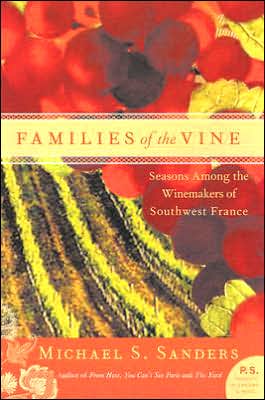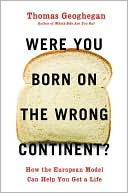Families of the Vine: Seasons among the Winemakers of Southwest France
Author Michael Sanders spent two years in the vineyards of southwest France with three families whose destinies are determined each year, every year, by the soil, the weather, and the quality of the grape, and shared with them the hopes of spring, the anguish of summer drought, and the mad rush of the fall harvest. In Families of the Vine, he offers a vivid, heartfelt portrait of these authentic winemakers in a fascinating, intensely human saga of strength, dedication, and savoir faire....
Search in google:
Sanders describes wine not merely as a commodity to be bought and sold, but a way of life in the Cahors region of France. He portrays family vineyards that are well established, intensely local operations, and represent three axes of coherent response to the difficult times French winemakers are facing as trade barriers fall both within the European Union and around the world. He does not provide an index or bibliography. Annotation ©2004 Book News, Inc., Portland, OR Library Journal To the south of the more familiar Bordeaux region lie the vineyards of Cahors (pronounced CAH-or) that have also produced robust wines for over 1000 years. Sanders (From Here, You Can't See Paris) turns his talents to following several families there during the ups and downs of the winemaking year. Through conversations, a bit of history, and vivid descriptions of occurrences outside the vintners' control (e.g., the devastating 2003 drought), the author aptly illustrates how family traditions, French regulations, climate, business skills, and the winemaker's expertise contribute to each year's production. Like William Echikson's Noble Rot: A Bordeaux Wine Revolution, Sanders's book brings contemporary winemaking in France to life. The text concludes with a brief guide on where to stay, where to dine, and sample wines in the Cahors appellation. Absorbing and informative; for larger public libraries and special collections.-Andrea R. Dietze, Orange Cty. P.L., Santa Ana, CA Copyright 2005 Reed Business Information.
1Yves and Martine Jouffreau at Clos de Gamot12Young man in a hurry : Philippe Bernede at Clos la Coutale193Man in the middle : Jean-Luc Blades at Clos Triguedina384A short history of Vin de Cahors565It's the terroir, stupid!786The long, hot summer897Harvest1208Vinification 2002 : making the wine1419Vines in winter17010A visit to the cooper19111Wine at the restaurant table : a few hours with Laurent Marre at Le Balandre21612Yves' folly : up on the mountain at Clos St. Jean24213Where to taste in Cahors257
\ Library JournalTo the south of the more familiar Bordeaux region lie the vineyards of Cahors (pronounced CAH-or) that have also produced robust wines for over 1000 years. Sanders (From Here, You Can't See Paris) turns his talents to following several families there during the ups and downs of the winemaking year. Through conversations, a bit of history, and vivid descriptions of occurrences outside the vintners' control (e.g., the devastating 2003 drought), the author aptly illustrates how family traditions, French regulations, climate, business skills, and the winemaker's expertise contribute to each year's production. Like William Echikson's Noble Rot: A Bordeaux Wine Revolution, Sanders's book brings contemporary winemaking in France to life. The text concludes with a brief guide on where to stay, where to dine, and sample wines in the Cahors appellation. Absorbing and informative; for larger public libraries and special collections.-Andrea R. Dietze, Orange Cty. P.L., Santa Ana, CA Copyright 2005 Reed Business Information.\ \ \ \ \ Kirkus ReviewsWith great respect and admiration, Sanders (From Here, You Can't See Paris, 2002, etc.) pores over the convivial and welcoming wines of southern France. As he chronicles a year among three of the region's producers, Sanders depicts French wine shorn of pretense, as a part of everyday life more than a commodity. The text focuses on vin de Cahors, a local petit vin grown in the valleys and hills of the Lot River. Sanders describes the elegance and specific geology of this ancient wine-producing region, which can trace its heritage back 2,000 years. He concentrates on three growers, delineating their various approaches and the little finesses they bring to their work. Winemaking here is in touch with its roots: coopers continue to make the barrels; no filtration subtracts from the wine's character; butterflies are looked upon warily as harbingers of blight. The narrative voice is as companionable as the subject-and bell clear, which readers might not be after a few glasses of dark, meaty Cahors wine, characterized by the author as an ordinary, unthreatening, but very tasteful drink. Recounting the education of a sommelier becomes the reader's education too. (How to get the right bottle for the meal? Ask!) Sanders salutes the local makers' iconoclasm. On the one hand, they are happy that vin de Cahors has been elevated to the status of an appellation controlee (certification of a certain level of quality), yet they also happily plant grapes outside the prescribed varietals, devoting an acre to cabernet franc or sauvignon blanc. As one grower said, "We make the white and the rose for our own amusement, because it makes a change, a little something different." A refreshing portrait of wine notas an elite mystery, but as a product wrung from the earth by honest labor.\ \








